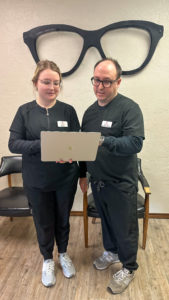
Dr. Allard with a scribe, who helps him work with contact lens patients to discover the “why” behind discomfort when it occurs.
By Tyson Allard, OD
Feb. 8, 2023
Contact lens patients are more profitable over the long term than spectacle-only patients, returning more frequently to your office for annual exams, which they need in order to renew their prescription. They also usually purchase glasses and sunwear, and sometimes receive treatment for conditions like dry eye disease, among other medical eyecare needs. Our practice takes a conscientious approach to keeping these patients in their contact lenses, and in our office.
In fact, we are developing a word-of-mouth reputation from referring doctors as experts in fitting contacts and as problem-solvers that enable patients to stay in their lenses.
Our already-high contact lens profitability metrics have improved even further. Our overall contact lens profits are up $12,000 from one year prior, representing a 5 percent, or $1,000 per month, increase. Our daily disposable contact lens profits are up 13.5 percent from one year prior.
Here is how we are spurring such growth in profitability in this area of our practice.
Get to the “Why”
Overarching all of our conversations with contact lens patients is understanding why their lenses are not comfortable.
The two most common answers to the question of why the patient is not happy in their lenses are comfort or clarity. These two can be connected, but I think it’s important to keep them separate as far as problem-solving with the patient. First, we approach the comfort issue, which is usually tied to ocular dryness. We treat that with dry eye treatments and then prescribe a more dry eye friendly option like daily disposable contact lenses or gas permeable lenses/sclerals.
The second reason for a patient to be unhappy is the clarity. Again, we will check for dryness, but my approach to this is to update or try a different contact lens by either brand or design.
Ask For Details in the Exam Room
It isn’t enough to ask the patient how they’re liking their contacts. As most of us know, they will likely just shrug their shoulders and say “fine,” even if they are dissatisfied.
“How often do you wear your contacts?” I might ask. If the patient used to wear their lenses everyday, or several times per week, and now are not wearing their lenses more than a few times a month, you know there is likely a problem. You can even bring up the dip in their contact lens wear evidenced by a change in their buying pattern. “Cindy, we noticed that you are not ordering as many contacts as you used to in the past,” you might say.
Other Articles to Explore
It may be that they are not wearing their lenses as often because they are now working at home, and being alone most of the day, don’t feel it’s worth wearing contacts. However, it also could be because the lenses have become so uncomfortable that they’re now reserved only for special occasions.
“How do your lenses feel at the end of a long day? Are they as comfortable at the end of the day as at the beginning?” If you ask this question, you may find that your patients’ expectations for their lenses are based on the quality of contact lenses from many years ago. They may not realize that there are now lenses that often feel just as good at the end of a long day as at the beginning.
Train Your Support Staff to Also Converse with the Patient About Their Contacts
Some patients feel more comfortable opening up about contact lens discomfort with a support staff member, rather than the doctor. Doctors are sometimes are seen as authority figures. There are patients who are hesitant to tell a doctor that something they prescribed is not working for them. That’s where your support staff comes into play.
The same questions asked by the doctor can elicit a different response when asked by a support staff employee. In our office, we enlist the help of our scribes in talking to patients further about their contact lenses. If the patient expresses dissatisfaction with their contacts to the scribe, the scribe can hand-off the conversation to the doctor, who can work with the patient to problem-solve.
When a scribe, or other member of your support staff team, is backing the doctor up in conversing with patients about their contact lens comfort, you have doubled your chances of capturing the information you need to keep patients in their lenses.
It may be that they are still in a monthly contact lens, which doesn’t meet their needs for convenience in wear. They don’t have the bandwidth in their lives for a contact lens routine, and are too often doing activities like swimming, or other sports, that can benefit from a fresh lens following the activity. It also could be that they still want to wear contacts, but more infrequently in their work-from-home lifestyle. It doesn’t make sense for them to store contacts in solution for weeks at at time, but instead, would make more sense to have a daily disposables that could be worn as needed and then simply thrown out.
It could also be that the daily disposable they were put into years ago, and was comfortable enough at the time, can now be improved with a newer design. It may be that a lens that was ideal for them 10 years ago, or more, is no longer as comfortable as the modern consumer expects contact lenses to be. The patient may be hearing from their friends how comfortable their contacts are, and is scratching their heads wondering why they are also wearing a daily disposable, but not having the same kind of experience.
As providers, we sometimes get stagnant in our prescribing habits. We need to remind ourselves of the many advancements in technology and design that can benefit the patient’s contact lens experience. This awareness of patients’ “why” will help you problem-solve, and keeping those patients in contact lenses will keep them happy and your practice more profitable.
 Tyson Allard, OD, is the owner of True Vision Optometric Group, which has three locations in Oklahoma. To contact him: tallard@truevisionoklahoma.com
Tyson Allard, OD, is the owner of True Vision Optometric Group, which has three locations in Oklahoma. To contact him: tallard@truevisionoklahoma.com

























